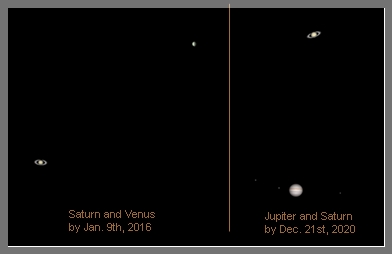
In the broader sense, an occultation is any celestial body intervening between another one and the observer. This definition encompasses solar eclipses, planetary transits on the Sun, or eclipsing mechanism of binary stars. More specifically, an occultation is the complete or partial disappearance of a celestial body behind another, the occulting body be lit, partially lit, or unlit, seen or unseen. There are various types of occultations. A conjunction, on a other hand, occurs when two objects have the same right ascension in the sky as should two bright planets come within 5 degrees of each other without a actual
conjunction in right ascension, that is called a 'quasi-conjunction' as defined by Belgian astronomer Jean Meeus
Occultations With Moon Implied
- occultations of stars by Moon: they are called "occultations of bright stars", although stars concerned are mostly about the magnitude 3 or 4. Some of such events occur each month along the year. The four bright stars located near the ecliptic, Aldebaran, Regulus, Spica, and Antares are enduring series of occultations, spaced by long periods of non-occultation. Each month, for any particular location, Moon is occulting more fainter stars
- occultations of planets by Moon: some such events are seen each year. For Jupiter and Saturn, annual occultations occur and are followed then by gaps of non-occultation years
- occultations of various celestial objects by the Moon: some faint open clusters are occulted each year due to their location near the ecliptic. The Pleiades are occulted each 13 years and 11 months with a series of occultations occurring then during about 5 years and 10 months. Next such series is now to begin by about October 2024 only
Occultations by Planets
- occultations of stars by the planets or their moons: such events are relatively frequent each year. They mostly implicate stars below the visual magnitude, which means that these events are mostly telescopic events only
- mutual occultations by planets: these are very rare events. None is to occur during the 21st century. Two remarkable closenesses between planets however are seen during the 21st century. A 6-minute closenes between Venus and Saturn on January 9th, 2016, and a 6-minute nearing on December 21st, 2020 between Jupiter and Saturn. Both events, when available, will have to be observed!
 | a view of both the 6-minute remarkable planetary closenesses forecast in the 21st century!. picture courtesy site 'Amateur Astronomy' |
Occultations by Asteroids
- occultations of stars by asteroids: such events are of the same type than occultations of stars by the planets and their moons. They are relatively numerous and may concern some stars of visual magnitude. Some Kuiper Belt objects may be observed each year occulting some fainter, 12th-13th magnitude, stars. A asteroid occultation occurs when an asteroid passes directly in front of a
star causing the star to disappear for some span of time, usually from several
seconds to a minute or more. A instantaneous drop in the light level of the
star and of the merged object can be observed. This fading is
caused by the asteroid's own light replacing the light of the brighter star. When
the asteroid too faint to be seen, the star vanishes completely while
the asteroid is in front of it
Jupiter Galilean Moons
- usual occultations: all year long, the four Galilean moons are enduring four types of astronomical events. They are either transiting on the foreground of Jupiter disk, projecting their shadow on the disk (solar eclipse at Jupiter), being eclipsed by Jupiter's shadow (moon eclipses), or they are occulted behind the planet's disk
- mutual occultations of Jupiter's moons: each six years, the combined orbits' plane and motions of the Earth and Jupiter make that Jupiter's four Galilean satellites motion is seen edge-on. They are then affected by mutual events, that is that they are either occulting, or eclipsing each other. Such series of events are lasting some months
Mechanism, Observation
As far as the Moon is concerned, the occulted body may be by the bright, or by the dark side of the Moon. A waxing Moon is occulting a star or a planet by its dark side as they will reappear on the bright side, as a waning Moon is occulting the object by its light side as the objects reappears on the dark side. The path's map for occultation are of the same type than those for the solar eclipses, with a northern and southern limit, and where the phenomenon is seen at moonrise or moonset. Each occultation generates too what is called a grazing occultation. A grazing occultation is the occultation seen just grazing the Moon's limb. The star or the planet is just skimmed by Moon's edge. The occultation is seen as a grazing occultation near the northern and southern limit of the occultation. Such grazing occultations are interesting as the occulted body is seen appearing and disappearing behind the lunar mountains and valleys. Generally, the Moon is moving by 0.5° per hour as it is ½° wide. Technically, occultations may be described in angle from either the nearest cusp of the Moon, from Moon's true North (true North of an object is the North referring to the equatorial coordinate system on the celestial sphere) or from Moon's north pole (the latter is useful for the reappearance). Most other occultations are represented too in the same way than solar eclipses, that is with a zone of visibility, delineated with a northern and a southern limit. We warn on our site about the most remarkable occultations only, as afficionados are bade to turn, as far as most usual ones are concerned, to dedicated sites on the Web, like the I.O.T.A site
Website Manager: G. Guichard, site 'Amateur Astronomy,' http://stars5.6te.net. Page Editor: G. Guichard. last edited: 1/12/2015. contact us at ggwebsites@outlook.com

